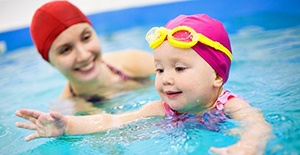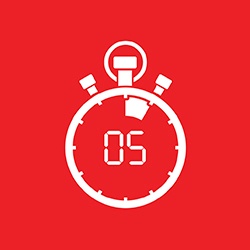Today we’re sharing insight from guest blogger Jenny Silverstone, editor at www.momlovesbest.com.
 Are you worried the lifeguard will have to give you CPR this summer for cardiac arrest while you worry over your child’s safety while they're swimming?
Are you worried the lifeguard will have to give you CPR this summer for cardiac arrest while you worry over your child’s safety while they're swimming?
Do you wonder what you can do to prevent your child from drowning?
Water safety, especially for young children, is a real issue you should worry about as a parent.
There are about 10 deaths from drowning in the United States every day. One in five of those people are children who are under the age of 14. That’s not even counting the people who die from drowning in boating accidents every year. (source)
Many other children who don’t die from drowning suffer other injuries in the water, like brain damage from lack of oxygen.
Like many moms, I worry about everything my child does. But as they say, prevention is the best cure. Armed with the right information, we can all sleep a little easier at night.
In this guide I will break down everything you should know to protect your children from drowning.
Swimming Safety Infographic
As Seen On...



Know The Facts
Knowing how often something happens can let you know how big of a risk it is to you and your family.
Compared to the drowning incidents in the United States, there are approximately 360,000 drowning fatalities each year throughout the world (source). That makes it the third most common cause of unintentional deaths in the world. Clearly, it’s a huge problem.
Certain countries have far higher drowning rates than other countries do. Angola is the country with the highest drowning rate (source). By comparison, the United States places 145th in the list of drowning rates by country.
Being a parent means worrying about every threat -- real or perceived -- all the time. It’s hard to fathom a fun day of swimming at the local pool turning into the last day of your child’s life, but for many people that nightmare becomes a reality.
Drowning can happen anywhere there is water -- it can be in a bathtub, a swimming pool, a pond, a river, the ocean, or a lake. For younger children, the most dangerous time is when there isn’t any supervision from an adult.
Warmer months are a heightened time for potential drownings simply because more people are in the water in an effort to beat the heat.
Here are some of the risk factors for drowning:
-
Age: Young children are most likely to drown.
-
Gender: Being male makes someone more likely to drown, perhaps because of risky behavior or drinking alcohol.
-
Being around water: Living near water that isn’t fenced off increases the risk of drowning for small children.
-
Floods: Living in areas that are at an increased risk of flooding gives children a greater chance of drowning.
-
Commuting on water: If you travel by water, you have a greater risk of drowning.
-
Minorities and having less money: Children who are minorities and who come from families with less education and lower economic status have an increased risk of drowning.
The Signs of Drowning
Before I became a mom, I didn’t worry about drowning very much. I was mainly looking out for myself, not any kids at that point. Most of what I knew about drowning came from movies and television. I thought people who were drowning were easy to spot -- they would be bobbing up and down in the water, yelling, and frantically waving their hands around. How could anyone miss those obvious signs?
But when I became a parent and started learning more about the risk of drowning, I learned this wasn’t always the case. Sometimes the signs of drowning aren’t obvious at all (source). And that’s what makes them especially scary to me.
It can literally take just a few seconds of an adult not paying attention for a kid to fall in the water, for a drowning to occur. And if it is happening right before your eyes, you might not even realize what’s going on until it’s too late.
Up to half of all kids who drown are less than 25 yards away from an adult when the drowning occurs (source).
Many times, a person who is drowning can’t call out for help. When a child’s mouth goes below the surface and then momentarily bobs back up before going under again, she can’t call out because she’s too busy trying to breathe.
Adults may be on the lookout for a child who is waving for help to indicate they are in trouble. But kids who are drowning are already instinctively using their arms in an attempt to keep their head above water. They can’t wave for help -- they are in a fight for their lives.
While many people assume children who are drowning will be loud and drawing attention to themselves, that’s not often the case. Often kids won’t even seem like anything is wrong to the casual observer. You may just notice the kid is looking up (source).
Here are the major signs a child may be drowning, and they may be dramatically different than what you expect.
-
There will be no call for help: If you can’t breathe, you can’t speak or yell.
-
You may see their mouths sinking and bobbing back up repeatedly: If you see bobbing going on, you should check on the kid who is doing it. He could be in distress and you might be missing the signs.
-
They won’t be waving for help: Their instinct is to use their hands to pull their mouths out of the water so they can breathe, not wave for help.
-
They won’t be able to help their rescuer: They won’t be able to call attention to themselves, grab onto rescue equipment, or reach out for a lifeguard.
-
They are upright in the water and may not be kicking: If you see a child who is upright and not kicking, along with any of these other signs, get to them as soon as possible.
-
The incident happens quickly: A person who is drowning doesn’t have much time -- they can only struggle for 20 to 60 seconds before they go under.
-
A child isn’t making any noise: As every parent can tell you, children who are playing in the water make a lot of noise. If your child can’t be heard anymore when she’s playing in the water, assume something is wrong.
Drowning Signs Checklist
Here are some other visual signs you can use to spot potential drowning victims:
How to Protect Your Children
Whenever my kids go in the water at the local pool, I always breathe a sigh of relief if I see there aren’t that many kids there. I always reason that the lifeguards and the adults at the pool will have an easier time spotting anything that’s going wrong than they would with a packed pool.
But the reality is, even if there aren’t many kids in the pool, it’s up to us adults to be vigilant the whole time our kids are in the water.
Here are some ways you can ensure your child’s safety in the water.
-
Make sure to supervise: No one cares more about your child’s safety than you do. You’ll be your child’s best watchdog when he’s in the pool because you are totally devoted to his safety.
-
Keep your eyes on your child: When you’re supervising your children in the water, you should concentrate 100 percent on that task. This isn’t the time to play Candy Crush or have a deep conversation with other parents who are watching their kids. You need to keep distractions at a minimum.
-
Lifeguards are your best bet: Lifeguards are trained to recognize the signs of drowning and they’ll likely spot any problems before any other adults will. Plus, they’ll have the training to quickly reach that kid and bring them to safety. Choose to swim at pools that have lifeguards on staff.
-
Keep your little kids right by you: Kids under the age of 5 should be right by you in water, not several feet away. By making sure you’re within reach of your child, you can avoid the possibility of your child drowning.
-
Don’t allow dunking: Kids like to dunk each other and sometimes parents even like to dunk their own kids. Dunking can be a dangerous situation because it can mask when someone really is in trouble.
-
Be aware of medical conditions: If your child has medical conditions, like seizures, that make it dangerous for him to swim. He will need close supervision.
-
Don’t let swimming toys give you a false sense of security: Just because your child has a swimming raft or a boogie board nearby, it doesn’t mean you can stop watching. It’s easy to fall off those toys or they can float away from your child when he most needs them.
-
Be prepared for emergencies: If you have a backyard pool, you should always have a flotation device ready to throw to the person who is drowning. After you’ve thrown it to them, jump in the water and get to him as soon as possible to assist. Plus, a first aid kit is a great thing to have at the pool at all times too.
-
Don’t drink alcohol: Drinking alcohol slows your reaction time (source). That means you might not recognize someone is drowning in time to do anything about it. Or, you’ll see it, but you won’t be much use to them because of your lack of coordination and how slowly you’ll be moving.
-
Check on the weather conditions: This is especially important before swimming in the ocean or bigger lakes where the waters will be extremely choppy depending on the weather. You should also get out of the water if there are any thunderstorms around you.
-
Avoid cramps: You shouldn’t eat a meal within an hour of swimming because you could get cramps that can lead to drowning. That’s also a good rule of thumb for children who have food allergies -- most severe allergic reactions to food happen within an hour or two of eating (source). They don’t want to have a severe allergic reaction while they are in the water.
-
Watch out for dangerous games: Kids, and adults for that matter, don’t always make the best choices. Be on the lookout for dangerous poolside activities like running on a slippery diving board, holding each other underwater, or diving into shallow water.
-
Know CPR: Knowing CPR might be the difference between saving someone’s life and sitting there helpless while they die. It’s not difficult to learn so take the time to do so.
-
Make your pool childproof: If you have a backyard pool, give some thought into child safety features.
When you’re going swimming at the beach, you have to be even more vigilant than you are at the pool. There are added dangers there like currents, waves, increased area for lifeguards to cover and seaweed and other vegetation your child can get tangled in.
Here are some tips for when you’re at the beach.
-
Invest in a good life jacket. That will give you some peace of mind.
-
Know what the various safety warnings or flags mean.
-
Talk to the lifeguard about water conditions that you should be aware of.
-
Letting the waves nip at your feet is fun, but don’t let your child wade in too far without you. Those waves can drag them in if you aren’t careful.
The scariest aspect of parenting for me is that at some point you have to let go and have faith that you’ve taught your children everything they need to know to stay healthy and safe. There are so many lessons and so little time.
To me, basic water safety is one of the most important lessons a kid can learn. It’s right up there with avoiding conversations with strangers and what to do when your house is on fire.
Teaching my child how to swim was one of my top priorities, even when my children were babies. Although they weren’t old enough for formal instruction, I did get them in the water frequently while they were wearing their floaties.
I wanted them to be comfortable enough in the water that when they were old enough for basic instruction, they wouldn’t panic at the thought of putting their face in the water.
Just because an adult knows how to swim doesn’t mean they will be good at teaching children how to do it. I’ve been swimming since my childhood days, but I didn’t have a clue as to how to teach my daughter to swim. Even though I was a good swimmer, it didn’t make me a good instructor.
I needed someone impartial who knew how to take baby steps to make swimming easier for my daughter. I also needed someone who my daughter wouldn’t get as frustrated with as she would with me.
But if you know how to break swimming down into easy steps for your child, you won’t have to pay for lessons with an accredited lifeguard like I did.
If you teach your child to swim on your own, here are some tips you may find handy.
-
You should teach your child from an early age that dunking is something they should avoid doing to others.
-
Teach them to never run while they are at the pool -- they can slip and hit their heads or slip and fall into the water.
-
Keep your eyes on your children at all times when you’re teaching them to swim.
-
Don’t leave toys in the pool. Your child might be so interested in reaching those toys that she’ll make foolish decisions.
-
Don’t expect too much too soon. She won’t learn how to swim in one lesson.
What Are the Key Swimming Skills Every Child Should Know?
There are certain skills that all kids will benefit from knowing. Some of these may seem extremely basic to you, but for a kid, it could be enough to save their life.
Child Swimming Basics
There are certain skills that all kids will benefit from knowing. Some of these may seem extremely basic to you, but for a kid, it could be enough to save their life.
Here are five things all kids should be able to do (source).
- Tread water or float for at least 60 seconds.
- Turn in a circle and be able to locate an exit.
- Swim at least 25 yards before exiting the water.
- Pull themselves out of the water without using a ladder.
- Jump into the water until they are fully submerged and be able to get back to the surface.
Make Sure Your Children Are Aware of Safe Behaviors Around Water
Children, even very young children, are capable of understanding simple rules. You don’t want to overwhelm young children by adding too many complex rules -- just stick with the basics. Which is what I like so much about the pledge.
I did also take the time to talk to my kids about other swimming rules that I thought were important, such as:
-
Don’t eat a big meal before you go swimming.
-
No chewing gum while swimming. You don’t want to add the risk of choking into the mix.
-
No swimming after dark. If people can’t see you, they can’t save you.
-
Always swim with a buddy.
-
Never act like you’re drowning just to get attention. It will stop people from knowing when you’re really in trouble.
-
Only swim while an adult is watching.
-
Make sure you drink water, even if you don’t feel thirsty after you’ve spent some time out in the sun.
-
Always use sunscreen to avoid sunburns.
-
Never swim during storms.
When your child spends most of her time swimming in contained areas like pools, here are some basics to teach them.
-
Reiterate that you don’t allow running around the pool. You should also let your child know that flips are out because she could hit her head.
-
Bikes and electronics are never to be brought near the pool.
-
If they don’t obey the pool rules, there will be consequences.
-
They needs to keep away from the drain. They are too tempting for kids to stick their fingers in.
-
Flotation toys should never be used as an alternative to careful supervision.
-
Children should learn never to go in deeper water than they can handle.
The rules for swimming in open water are different than those for swimming at pools. But these are crucial for children to learn as well.
-
Make sure you never swim where the lifeguard can’t see you.
-
Don’t swim out very far.
-
Children should never swim alone.
-
Keep away from piers.
-
If you find yourself caught in a rip current, you should swim parallel to the shore instead of directly toward it. You may be able to get out of the current (source).
-
Face the waves instead of swimming or walking away from them. Small children can be knocked over by waves as they walk back toward the shore.
-
Use water shoes to protect a child’s feet.
-
Make sure kids are always wearing life jackets in open water.
Cardiopulmonary resuscitation is a way to keep oxygen and blood flowing in a body long enough to protect the vital organs until an airway obstruction, like in the case of drowning, is cleared or until a defibrillator is used to restart a heart (source).
If you want to learn how to do CPR but aren’t sure where you can learn it at, you can contact your local hospital which may have training courses available. You can also contact the American Red Cross which routinely offers training.
Years before I had my children, I took CPR training for a summer job I had when I was in college. I never had to use it, but knowing I knew it made me feel more confident, more useful. I found the best way to learn CPR was by using the practice dummy at the courses I attended. Watching videos of CPR being performed was also helpful to me.
Here is a list of steps you’ll take while performing CPR on children or babies(source).
-
Quickly evaluate the scene to make sure it’s safe for you to approach to administer CPR. You’ll want to make sure the child actually needs help by tapping her on the shoulder and calling out, “Are you okay?” If there’s no answer, proceed with CPR. For babies who won’t be able to answer, flick their foot on the bottom to see if there is a reaction.
-
Call 911 if you determine it’s an emergency or if you’re uncertain what state a child is in. Better yet, if there is anyone else on the scene who can call 911, you can start CPR faster. For kids who don’t respond, you’ll want to give CPR for approximately two minutes before reassessing the child.
-
For a drowning victim, you’ll want to turn the child’s head to one side because that lets water come out of the nose and mouth. Then you’ll turn the head back to the center. You’ll also want to begin CPR immediately instead of calling 911 if there is no one there to help you. Your first job should be getting the water out of the victim’s lungs.
-
When the child is on her back, tilt her head back a little and lift her chin. That opens her airway.
-
Listen for breathing. Don’t listen for longer than 10 seconds because time is valuable in a crisis.
-
Give two rescue breaths to children who aren’t breathing. While the head is tilted back, pinch the kid’s nose closed, put your mouth over the child’s mouth and breath into it. For babies, you’ll cover the mouth and nose with your mouth and blow for one second. Watch to see if the baby’s chest is rising. Then do two rescue breaths.
-
If the rescue breaths don’t work, start CPR.
-
Kneeling by the child, you’ll push hard and quickly on the center of the chest using the heel of your hand. You’ll do 30 compressions, moving the chest down about 2 inches deep with each one. For infants, you’ll only use two fingers instead of the heel. You’ll still do 30 compressions, but they should only go 1.5 inches deep.
-
After the compressions, give two more rescue breaths.
-
Keep doing CPR until the baby begins breathing or her own or medical professionals arrive.
When my baby was born, I spent a lot of time walking through my house to childproof every potential hazard I could find. I was a woman on a mission.
While family and friends thought I was being too nit picky, I was convinced that my child could pay a steep price if I overlooked one thing. That same level of attention should be given to childproofing pools.
If you want to avoid accidents, you need to think like a child would. You should:
-
Take pool toys out of the water as soon as you’re done with them.
-
Furniture should be away from the edges of the pool.
-
You should always have rescue equipment near the pool. You’ll lose precious seconds if you have to rummage through a closet for equipment that you need.
-
Keep those drains covered so kids won’t stick their little fingers through them.
-
Make sure there aren’t hoses or extension cords running along different areas of the deck where your child could trip on them.
-
Keep the pool covered when you’re not using it. That reduces the risk your child will potentially drown in the pool if they sneak out to use it.
-
Don’t leave a ladder next to the pool. That gives your child easy access.
-
Put a rope in your pool to let swimmers know where the deeper water begins (source).
Drains naturally draw children’s attention. They look different than the rest of the pool so they become an instant area of attraction for children who are curious about the differences they see.
If you’re in the process of putting in a pool, consider the type of drain you want to have. The biggest threat comes from flat drain grates or pools that have only one main drain area (source). So, if you have the choice, put more than one drain in hot tubs and pools. That’ll mean less suction on each drain, which gives your child a better chance of pulling away if he gets too close to the drain.
To protect kids from drains, you should get anti-entrapment drain covers. Inspect your drain covers monthly to make sure there aren’t any cracks.
And all drains should have safety vacuum release systems that can shut the suction off right away if anyone is in danger.
Purchases to Help You Childproof Your Pool
The best thing you can do to prevent accidental drownings in your pool is to have a fence completely around it. You should make sure your fence is:
-
At least four feet tall and it shouldn’t have any places for children to climb it, which means no ladders permanently attached and no footholds (source).
-
Not be made of chain link material because that is too easy for kids to climb.
-
Made with a self-closing gate. The latches to the gate need to be taller than kids can reach.
-
Your fence should also have quality locks on it.
For added protection, you can also buy alarms for your pool or door that will alert you when someone is trying to get in. These are extra handy when you have small children in your household.
Kids can find the sneakiest ways to get what they want and extra pool time would likely be high on their list. Since little kids live very much in the moment and they don’t have the ability to reason out what the consequences of their actions can be, a pool alarm may save a life.
My family and I have had some of our most memorable moments in the water, whether it’s been at the local pool or beaches while on vacation. Swimming is a great way to spend a hot day and it offers some of the best exercise you can get.
You should never be scared to head out for a day of swimming with your family. Just paying close attention to your surroundings and your children will be enough. Education is the key to staying safe. Have fun and enjoy your family.
What are your best tips for staying safe in the water? I’d love to hear what other families do.
This content was written and shared by guest blogger, Jenny Silverstone.
 Jenny is just another Mom trying to do her Best. She loves organizing things into lists and helping others find what they are looking for. When she's not using her powers to find her kids missing socks, you can find her giving actionable parenting advice & buyers guides at MomLovesBest.com.
Jenny is just another Mom trying to do her Best. She loves organizing things into lists and helping others find what they are looking for. When she's not using her powers to find her kids missing socks, you can find her giving actionable parenting advice & buyers guides at MomLovesBest.com.




